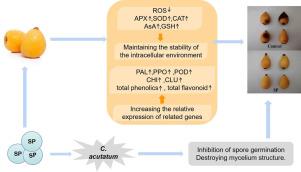Scientia Horticulturae ( IF 4.3 ) Pub Date : 2022-06-10 , DOI: 10.1016/j.scienta.2022.111246 Fen Yan , Dan Zhang , Xue Wang , Cong Liu , Fan Zhang

|
Anthracnose caused by Colletotrichum acutatumis the most common disease-causing decay duringthe postharvest storage of loquat fruit.The use of serine proteasecould reduce decay of the fresh fruits during storage. However, the postharvest studies with the serine protease are limited. This study explored the mechanism of keeping loquat fruit fresh by serine protease. In vitro, SP treatment resulted in abnormal hyphae of C. acutatum, damaged plasma membrane integrity and decreased spore germination rate. Then we applied the best concentration of SP of 120 mg•L−1to explore its effect on loquat fruit. Test fruits were exposed to 2 different treatments, which are (i) serine protease (120 mg•L−1)+ C. acutatum, (ii)sterile water + C. acutatum as control. In vivo, SP treatment could regulate reactive oxygen species (ROS) metabolism of loquat fruit by enhancing the activities of catalase (CAT), superoxide dismutase (SOD) and ascorbate peroxidase (APX), and activating AsA-GSH circulatory system. SP treatment improved the disease resistance of loquat fruit to C. acutatum by enhancing the activities of phenylalanine ammonia lyase (PAL), peroxidase (POD), polyphenol oxidase (PPO), chitinase (CHI) and β-1,3-glucanase (GLU), promoting the accumulation of total phenolics and flavonoid. In addition, Spraying SP could increase the relative expression of genes related to fruit disease resistance (PAL, PPO, PR-1, TLP, ERF2, ERF4, WRKY22, GST). The results showed that the SP could inhibit the growth of C. acutatum, enhance the resistance of loquat fruit to pathogenic fungi, reduce postharvest decay, maintain postharvest quality and it was an effective biological preservative.
中文翻译:

丝氨酸蛋白酶减少枇杷果实采后病害及其可能机制
由刺炭疽菌引起的炭疽病是枇杷果实采后贮藏过程中最常见的腐烂病害。丝氨酸蛋白酶的使用可以减少鲜果贮藏过程中的腐烂。然而,用丝氨酸蛋白酶进行的采后研究是有限的。本研究探讨了丝氨酸蛋白酶对枇杷果实保鲜的机制。在体外,SP处理导致尖刺孢子菌菌丝异常,质膜完整性受损,孢子萌发率降低。然后我们应用最佳SP浓度120 mg•L -1来探讨其对枇杷果实的影响。将试验果实暴露于 2 种不同的处理中,即 (i) 丝氨酸蛋白酶 (120 mg•L -1 )+ C. acutatum, (ii) 无菌水 + C. acutatum作为对照。在体内,SP处理可通过增强过氧化氢酶(CAT)、超氧化物歧化酶(SOD)和抗坏血酸过氧化物酶(APX)的活性,激活AsA-GSH循环系统来调节枇杷果实的活性氧(ROS)代谢。SP处理通过增强苯丙氨酸解氨酶(PAL)、过氧化物酶(POD)、多酚氧化酶(PPO)、几丁质酶(CHI)和β-1,3-葡聚糖酶(GLU)的活性来提高枇杷果实对尖刺枇杷的抗病性),促进总酚类和类黄酮的积累。此外,喷施SP可提高果实抗病性相关基因(PAL、PPO、PR-1、TLP、ERF2、ERF4、WRKY22、GST)的相对表达量。)。结果表明,SP能抑制C. acutatum的生长,增强枇杷果实对病原真菌的抗性,减少采后腐烂,保持采后品质,是一种有效的生物保鲜剂。



























 京公网安备 11010802027423号
京公网安备 11010802027423号